
Production of Common Carp (Cyprinus carpio var. communis) and Grass Carp (Ctenopharyngodon idella) Fingerling in a Polyculture System in Chitwan, Nepal
*Corresponding Author(s):
Subodh PokhrelMasters In Tropical Aquaculture, Can Tho University, Vietnam
Tel: +84 1269366587,
Email:aquasubodh@gmail.com
Abstract
Aquaculture is still in subsistence level in Nepal. Inadequate supply of fry and fingerlings has been a major problem to expand aquaculture. Quality seed production, rearing and management have been a problem for so long. With an objective to find out the proper rearing technique of nursing fry and production of fingerlings a study was conducted in the aquaculture farm of Agriculture and Forestry University, Chitwan, Nepal. In this study, one earthen pond of 323 m2 was prepared and polyculture of the common carp and grass carp fry were done. The fry were fed 2 times a day with 28 % CP feed at the rate of 2 % of the body weight. Periodic water quality assessment and fertilization was done to control water quality and natural food production. Periodic samplings were done to evaluate the daily weight gain, specific growth rate, survival rate, and change in water quality parameters. All cost incurred was also recorded to perform an economic analysis. The water quality parameters were found suitable for growth of fry. The average daily weight gain of common carp and grass carp was found to be 0.41 and 0.1 g/fish/day and survival rate of 29.71 % and 20.21 % respectively. The Specific Growth Rate was 7.32 %/day and 5.87 %/day for common carp and grass carp respectively which was found to be relatively higher. The economic analysis revealed that rearing of common carp and grass carp fry to produce fingerlings is profitable venture.
Keywords
Common carp; Fingerlings; Grass carp; Growth rate; Polyculture
INTRODUCTION
Aquaculture in Nepal was started in 1940’s in small scale ponds by introducing the seed of Indian major carp from India. While common carp (Cyprinus carpio) and grass carp (Ctenopharyngodon idella) was introduced from India (1950)/Israel (1960) and from Japan in 1970 respectively [1]. Aquaculture is still subsistence type except raceways and mostly carps are emphasized to grow as they can sustain with natural foods [2]. Aquaculture is still limited on extensive and semi-intensive system. About 90 % of aquaculture production is dominated by carp polyculture [3].
Like other agriculture enterprises, seed is an important input in aquaculture [4]. Seed production subsequently started with successful breeding of Common carp in 1960’s [5]. The increasing number of fish ponds each year has demanded more number of fish fry and fingerling. However inadequate supplies of quality fry and fingerlings have been a major problem in expanding the culture in the country [6]. In Nepal seed are distributed in three forms: Hatchlings, fry and fingerlings. For quality seed production preparation and maintenance of nursery and rearing ponds are important steps in carp hatchery operations [7].
Common carp and Grass carp are mostly cultured in Nepal. Common carp dwells in the bottom and feed on the bottom insects, insect larvae, zooplankton, dead and decayed vegetation [7], whereas grass carp dwells in the middle layer and feeds on aquatic vegetation, terrestrial plants and plankton in the water column with same habit of warm water fish [8]. So the idea is to rear them together in the same pond as they utilize the two different niches of the pond.
MATERIALS AND METHODS
Site of study
The nursing of the common carp and grass carp was done in Aquaculture farm of Agriculture and Forestry University, Rampur, Chitwan. Earthen pond of size (23 × 14 m) was used for the nursing of fries to fingerling production.
Methods and methodology
Pond preparation was done by draining and drying of the pond. Liming was done at the rate of 250 Kg/ha for disinfection. Urea (0.54 Kg) and DAP (1.127 Kg) was used for fertilization. A total of 10,368 common carp fry of average weight 0.51 g and 10,048 grass carp fry of average weight 0.26 g were stocked in the prepared pond and cultured for 51 days until they reach fingerlings size.
Pellet feed of 28 % CP was fed two times a day at a rate of 2 % of total body weight. Periodic fertilization using organic (cow dung) and inorganic (DAP and Urea) was done to produce the natural foods, phytoplankton and zooplanktons.
Water quality parameters like temperature, dissolved oxygen, pH and transparency were monitored regularly during the whole culture period. Table top Microprocessor pH meter was used to monitor temperature and pH, Lutran’s DO 5519 DO meter was used to monitor dissolved oxygen and Sechhi disk for water transparency.
Sampling was performed on weekly basis, 10-15 fish sample was collected and length & weight of the fish was measured. Weight gain, condition factor, daily weight gain (g/day) and Specific growth rate were calculated using the following formula:
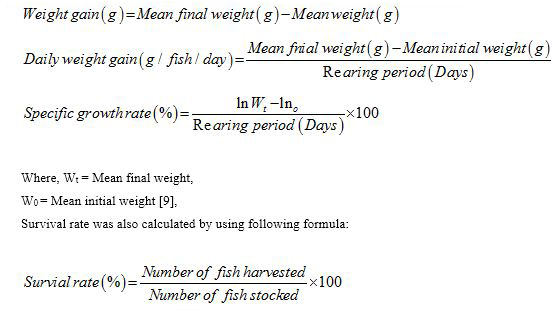
Simple economic analysis was done to calculate economic expenses and economic returns from the fingerling production. Gross margin and gross return were analyzed from total variable cost (operational cost) and total value of fingerlings. The variable cost includes the cost of fry, liming, fertilization and feeds required for the rearing based on current market price. Gross margin and gross return were calculated based on produce sold at farm gate prices. Gross margin, variable costs, gross returns and BC ratio were calculated by using following formula:
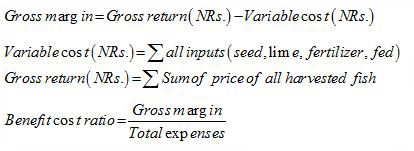
RESULTS
All the data collected from the experiment were analyzed to produce fruitful information. Result of the experiment is presented below under different headings.
FISH GROWTH
The average weight and length of common carp and grass carp during stocking was 0.51 g & 2.79 cm and 0.26 g & 2.46 cm respectively. The average final weight and average final length of common carp and grass carp was 21.37 g & 9.48 cm and 5.372 g and 7.21 cm respectively. The average weight gain of common carp was 20.86 g and grass carp was 5.112 g. The mean daily weight gain of common carp was 0.41 g/fish/day and grass carp was 0.1 g/fish/day. The specific growth rate is 7.32 %/day in common carp and 5.87 %/day in grass carp. All the observed data are tabulated below in table 1 below.
|
Parameters |
Common carp |
Grass carp |
|
Mean initial weight (g/fish) |
0.51 ± 0.53 |
0.26 ± 0.21 |
|
Mean initial length (cm/fish) |
2.79 ± 0.96 |
2.46 ± 0.48 |
|
Mean final weight (g/fish) |
21.37 ± 18.29 |
5.372 ± 1.57 |
|
Mean final length (cm/fish) |
9.48 ± 2.61 |
7.21 ± 1.07 |
|
Weight gain (g/fish) |
20.86 |
5.112 |
|
Mean daily weight gain (g/fish/day) |
0.41 |
0.1 |
|
Specific growth rate (%/day) |
7.32 |
5.87 |
Table 1: Stocking weight and length, harvest weight and length, weight gain and daily weight gain (Mean ± SD) of fry during the rearing period.
Figures 1 and 2 shows the average weight gain and average length of the common carp fry recorded during each sampling respectively. Likewise figures 3 and 4 illustrate the average weight gain and average length of the grass carp fry recorded during each sample respectively.
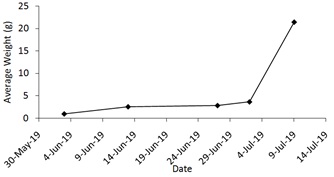 Figure 1: Average weight of common carp at each sampling.
Figure 1: Average weight of common carp at each sampling.
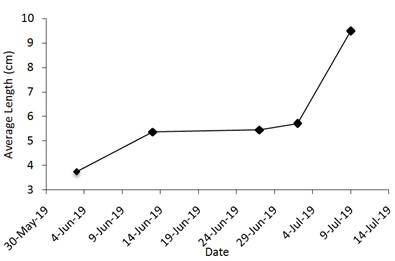 Figure 2: Average length of common carp during each sampling.
Figure 2: Average length of common carp during each sampling.
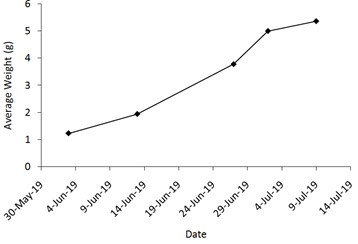 Figure 3: Average weight of grass carp in each sampling dates.
Figure 3: Average weight of grass carp in each sampling dates.
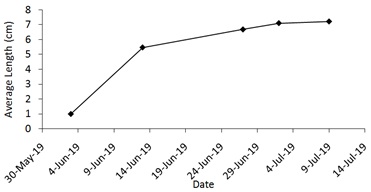 Figure 4: Average length of grass carp in each sampling.
Figure 4: Average length of grass carp in each sampling.
FISH SURVIVAL
Fish mortality was observed during the culture period. At the final harvest the number of fish survived was found to be 3080 common carp and 2031 grass carp. So, the survival rate calculated was 29.71 % of common carp and 20.21% of grass carp which is tabulated below in table 2.
|
Species |
Number of fish stocked |
Number of fish harvested |
Survival rate (%) |
|
Common carp |
10,368 |
3,080 |
29.71 |
|
Grass carp |
10,048 |
2,031 |
20.21 |
Table 2: Survival rate (%) of common carp and grass carp.
WATER QUALITY
The average temperature recorded during the rearing period was found to be 30.1 ± 1.57°C and range was from 26.5°C to 31.9°C. The average of pH was 6.43 and ranges from 5.45 to 9.8. The mean Dissolved oxygen observed was 4.86 ± 1.73 mg/L and range was from 1.9 mg/L to 9.6 mg/L. The average value of transparency was 15.1 ± 9.08 cm and ranges from 3.4 cm to 39 cm. Average values and range of water quality parameters measured during the rearing period are presented in table 3.
|
S.N. |
Parameters |
Average Value |
Range |
|
1 |
Temperature |
30.1 ± 1.6°C |
26.5 - 31.9°C |
|
2 |
pH |
6.4 |
5.6 - 9.8 |
|
3 |
DO |
4.9 ± 1.7 mg/L |
1.9 - 9.6 mg/L |
|
4 |
Transparency |
15.1 ± 9.1 cm |
3.4 - 39.0 cm |
Table 3: Average value with standard deviation and range of water quality parameters of pond water during the rearing period.
Water temperature, pH, Dissolved oxygen and transparency were recorded and average value calculated per week is plotted in a graph. Figures 5-8 shows the graph of change in water temperature, pH, dissolved oxygen concentration and transparency of the rearing pond respectively.
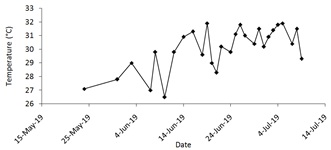 Figure 5: Water temperature (°C) observed during the rearing period.
Figure 5: Water temperature (°C) observed during the rearing period.
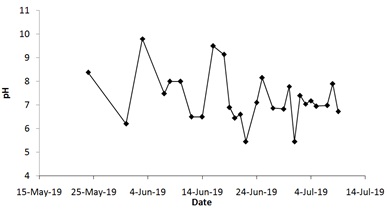 Figure 6: Water pH observed during the rearing period.
Figure 6: Water pH observed during the rearing period.
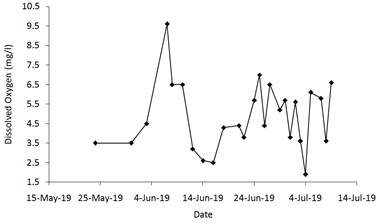 Figure 7: Dissolved oxygen observed during the rearing period.
Figure 7: Dissolved oxygen observed during the rearing period.
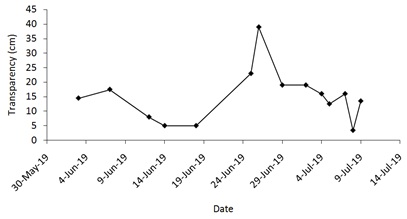 Figure 8: Transparency observed during the rearing period.
Figure 8: Transparency observed during the rearing period.
ECONOMIC ANALYSIS
Gross return, gross margin, benefit cost ratio and total variable cost involved in production of fingerlings are shown in table 4. The variable inputs were fry, lime, urea, DAP, feed, etc. The harvested fingerlings were sold to Aquaculture Farm, AFU, Rampur, Chitwan. According to the study, the total gross margin of the study was found to be NRs. 10831.39 and BC ratio was 1.43.
|
S.N. |
Variables Variable Cost |
Quantity |
Rate (NRs) |
Amount (NRs) |
|
1 |
Common carp |
10368 |
0.4 |
4147.2 |
|
2 |
Grass carp |
10048 |
0.25 |
2512 |
|
3 |
Lime |
14.19 |
12 |
170.28 |
|
4 |
Urea |
0.539 |
20 |
10.78 |
|
5 |
DAP |
1.127 |
50 |
56.35 |
|
6 |
Pellet feed |
9 |
65 |
585 |
|
7 |
Diesel |
1 |
100 |
100 |
|
A |
Total variable cost |
7581.61 |
||
|
1 |
Common carp |
3080 |
4 |
12320 |
|
2 |
Grass carp |
2031 |
3 |
6093 |
|
B |
Total Gross Return |
18413 |
||
|
C |
Gross Margin (B-A) |
10831.39 |
||
|
D |
B/C ratio (C/A) |
1.43 |
||
Table 4: Total variable cost, total gross return, gross margin and benefit cost ratio of fry rearing.
DISCUSSION
The daily weight gain of common carp (0.41 g/fry/day) which is comparatively higher than (0.1 g/fry/day) grass carp. Comparatively low DWG in both species can be due to less response of these species to commercial diet (28 % CP) used in rearing. The fry of common carp responded better to Decapsulated Artemia Cyst (DAC) and obtained highest weight gain when compared to commercial diets containing 53.39 % CP [10].
This study shows specific growth rate of common carp to be 7.32 %/day when fed 2 times a day at the rate of 2 % of the body weight while common carp fed 2 times a day at the rate of 5 % ration level only showed SGR of 2.58 %/day in indoor fish rearing system [11]. The high SGR may be due to the earthen pond in which the present study was conducted.
The survival rate of common carp and grass carp was observed 29.71 % and 20.21 % respectively. Higher survival rate of common carp might be due to low DO tolerance capability of grass carp [12]. The low survival of both species may also be due to predation because many predators like pond heron (Ardeola grayii), king fisher (Alcedo atthis), black stork (Ciconia nigra), water snake (Netrixpiscator) and tortoise (Lissemys punctate) were reported in Rampur, marshy land area [13].The rearing pond was also in open systems, which might cause high mortality of fry in rearing pond.
The BC ratio of the fingerling production in this study was 1.43. Benefit cost ratio (BC ratio) is a technique that is used for evaluating an investment by comparing the economic benefits with the economic costs which must exceeds one in profitable business [14]. This suggests that fingerling production in earthen ponds is profitable business.
CONCLUSION
Fry rearing is an activity which involves nurturing of the fry of size 1.0 to 3.0 cm up to the size of fingerling which can be used later for grow out. The fry rearing of Common carp and Grass carp can be conducted in the month of May after the breeding of Common carp and Grass carp occurs. Fingerling production in earthen ponds can be done with proper water quality management. The fingerling of both common carp and grass carp can be produced successfully in earthen ponds of Terai region of Nepal. The daily weight gain and growth of common carp is very good in earthen ponds as compared to grass carp. Predation control and appropriate water quality management as well as quality feed can improve the survival rate of the fries. It is economically feasible to rear common and grass carp in the same pond but still need more research for the co culture rearing of both species in a same pond.
ACKNOWLEDGEMENT
We would like to thank Mr. Rahul Ranjan for his continuous support during the research work. We are grateful for his insightful suggestions and sharing his pearls of wisdom with us during the course of this research. We would also like to thank Prof. Dr. Dilip Kumar Jha for his valuable support and suggestion during the manuscript preparation. We would also like to thank Department of Aquaculture and Fisheries and Aquaculture farm of Agriculture and Forestry University for providing the resources to carry out this research work.
REFERENCES
- FAO (1997) Fishery and aquaculture country profile, Nepal: Country profile fact sheets. FAO, Rome, Italy.
- Gurung TB (2003) Fisheries and aquaculture activities in Nepal. Aquaculture Asia 8: 14-19.
- CFPCC (2018) Annual progress report of 2017/18. Central for fisheries promotion and conservation center, Balaju, Kathmandu. Pg no: 1-132.
- Mishra RN (2015) Status of aquaculture in Nepal. Nepalese Journal of Aquaculture and Fisheries 2: 1-12.
- FAO (2004) Cultured aquatic species information programme. Cyprinus carpio. FAO, Rome, Italy.
- Jha DK, Bhujel RC, Anal AK (2015) Survival rate of hatchling, fry and fingerling of carps in private fish hatcheries in Nepal. Nepalese Journal of Aquaculture and Fisheries 2: 65-75.
- Jhingran VG, Pullin RS (1985) A hatchery manual for the common, Chinese and Indian major carps. Asian Development Bank, Metro Manila, Philippines.
- Shrestha MK, Pandit NP (2017) A text book of principles of aquaculture. Aquaculture and fisheries program, faculty of animal science, veterinary science and fisheries. Agriculture and Forestry University, Rampur, Chitwan, Nepal. Pg no: 82.
- Elliott JM, Hurley MA (1995) The functional relationship between body size and growth rate in fish.Functional Ecology 9: 625-627.
- Solomon SG, Tiamiyu LO, Fada A, Okomoda VT (2015) Comparative growth performance of common carp (Cyprinus carpio) fry fed dried quail egg and other starter diets in indoor hatchery. Journal of Fisheries Sciences.com 9: 346.
- Sultana SM, Das M, Chakraborty SC (2001) Effect of feeding frequency on the growth of common carp (Cyprinus carpio) fry.Bangladesh Journal of Fisheries Research 5: 149-154.
- Flajshans M, Hulata G (2007) Common carp - Cyprinus carpio. In: Genimpact-evaluaton of genetic impact of aquaculture activities on native populations. Corosetti E, Garcia-Vasquez, Veerspoor E (Eds.). Sixth Framework Plan of the Ec, Final scientific report.
- Shrestha TK, Jha DK (1993) Introduction to fish culture. Tribhuwan University, IAAS, Rampur, Chitwan, Nepal.
- Shively G (2012) An overview of benefit-cost analysis. Pg no: 1-10.
Citation: Balami S, Pokhrel S (2020) Production of Common Carp (Cyprinus carpio var. communis) and Grass Carp (Ctenopharyngodon idella) Fingerling in a Polyculture System in Chitwan, Nepal. J Aquac Fisheries 4: 027.
Copyright: © 2020 Sujita Balami, et al. This is an open-access article distributed under the terms of the Creative Commons Attribution License, which permits unrestricted use, distribution, and reproduction in any medium, provided the original author and source are credited.

